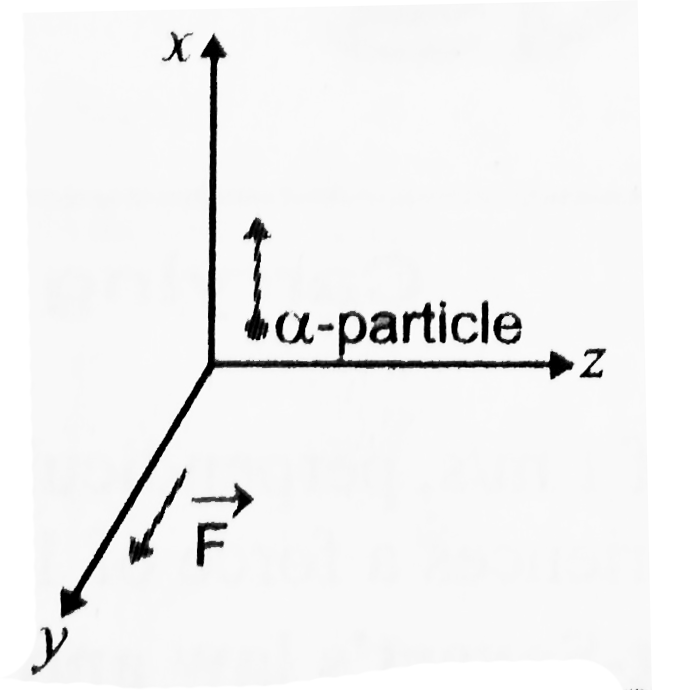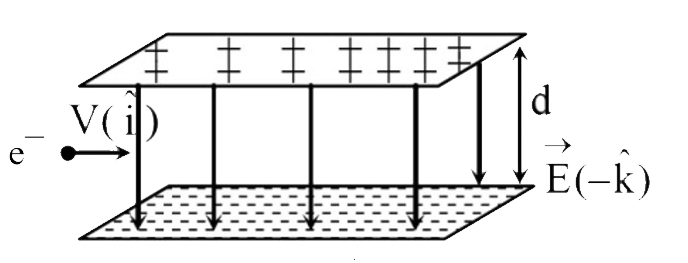An electron beam projected along + X-axis, experience a force due to a magnetic field along the + Y-axis. What is the direction of the magnetic field?
To determine the direction of the magnetic field when an electron beam is projected along the +X-axis and experiences a force along the +Y-axis, we can use the right-hand rule and the formula for the magnetic force on a charged particle.
1. Identify the Given Information:
- The electron beam is moving along the +X-axis.
- The force experienced by the electron beam is along the +Y-axis.
2. Use the Formula for Magnetic Force:
- The magnetic force F on a charged particle is given by the equation:
F=q(v×B)
- Here, q is the charge of the particle (negative for an electron), v is the velocity vector, and B is the magnetic field vector.
3. Determine the Direction of the Velocity Vector:
- Since the electron beam is moving along the +X-axis, we can represent the velocity vector as:
v=v^i
- where v is the speed of the electron beam and ^i is the unit vector in the X-direction.
4. Determine the Direction of the Force Vector:
- The force is acting along the +Y-axis, which can be represented as:
F=F^j
- where F is the magnitude of the force and ^j is the unit vector in the Y-direction.
5. Apply the Right-Hand Rule:
- According to the right-hand rule for the cross product, if you point your fingers in the direction of v (along +X) and curl them towards F (along +Y), your thumb will point in the direction of B.
- Since the electron has a negative charge, we will consider the opposite direction of the magnetic field.
6. Determine the Direction of the Magnetic Field:
- If we follow the right-hand rule, the magnetic field B must be directed along the +Z-axis. However, since we are dealing with an electron (which has a negative charge), the effective direction of the magnetic field that causes the force to act in the +Y direction will be along the -Z-axis.
Final Answer:
The direction of the magnetic field is along the -Z-axis.
- The electron beam is moving along the +X-axis.
- The force experienced by the electron beam is along the +Y-axis.
- The magnetic force F on a charged particle is given by the equation:
F=q(v×B)
- Here, q is the charge of the particle (negative for an electron), v is the velocity vector, and B is the magnetic field vector.
- Since the electron beam is moving along the +X-axis, we can represent the velocity vector as:
v=v^i
- where v is the speed of the electron beam and ^i is the unit vector in the X-direction.
- The force is acting along the +Y-axis, which can be represented as:
F=F^j
- where F is the magnitude of the force and ^j is the unit vector in the Y-direction.
- According to the right-hand rule for the cross product, if you point your fingers in the direction of v (along +X) and curl them towards F (along +Y), your thumb will point in the direction of B.
- Since the electron has a negative charge, we will consider the opposite direction of the magnetic field.
- If we follow the right-hand rule, the magnetic field B must be directed along the +Z-axis. However, since we are dealing with an electron (which has a negative charge), the effective direction of the magnetic field that causes the force to act in the +Y direction will be along the -Z-axis.
The direction of the magnetic field is along the -Z-axis.
Topper's Solved these Questions
- XII BOARDSBook:XII BOARD PREVIOUS YEAR PAPER ENGLISHChapter:XII BOARDSExercise:SET -III
Explore 4 Videos
- XII BOARDSBook:XII BOARD PREVIOUS YEAR PAPER ENGLISHChapter:XII BOARDSExercise:PHYSICS (Theory) [SET -I]
Explore 25 Videos
- XII BOARDSBook:XII BOARD PREVIOUS YEAR PAPER ENGLISHChapter:XII BOARDSExercise:SET -I
Explore 29 Videos
- SAMPLE PAPER 2019Book:XII BOARD PREVIOUS YEAR PAPER ENGLISHChapter:SAMPLE PAPER 2019Exercise:SECTION D
Explore 6 Videos
Similar Questions
A beam of α particles projected along + x-axis, experiences a force due to a magnetic field along the +y-axis figure. What is the direction of magnetic field.

View SolutionAn electron beam projected along the positive x-axis deflects along the positive y-axis deflects . If this deflection is caused by a magnetic field, what is the direction of the field? Can we conclude that is parallel to the z-axis?
View SolutionAn electron is moving along positive x-axis A unifrom electric field exists towards negative y-axis. What should be the direction of magnetic field of suitable magnitude so that net force of electrons is zero .
View SolutionAn electron is projected along positive z-axis, magnetic field is present along y-axis then direction of initial acceleration of the particle is
View SolutionA magnetic of magnetic moment placed along the X-axis in an magnet field .Find the torque acting on the magnetic field
View SolutionAn electron beam projected along positive x-axis deflects along the positive y-axis. If this deflection is caused by a magnetic field, what is the direction of the field?
View SolutionWhen a proton has a velocity v=(2ˆi+3ˆj)×106ms, it experience a force F=−(1.28×10−13ˆk) When its velocity is along the z-axis, it experience a force along the x-axis. What is the magnetic field?
View SolutionWhen as proton has a velocity v=(2ˆi+3ˆj)×106ms, it experience a force F=−(1.28×10−13ˆk) When its velocity is along the z-axis, it experience a force along the x-axis. What is the magnetic field?
View SolutionThe parallel plate capacitor has potential difference of 100 V and separation between the plate is 1 mm. An electron is projected along x axis in between the plates. If the electron comes out of the plates along the x axis undevated then the magnitude and direction of magnetic field that must be applied between the plates : (particle is projected with a velocity of 105m/s along x axis)

View SolutionAssertion : Magnetic force is always perpendicualr to the magnetic field.
Reason : Electric force is along the direction of electric field.
View Solution